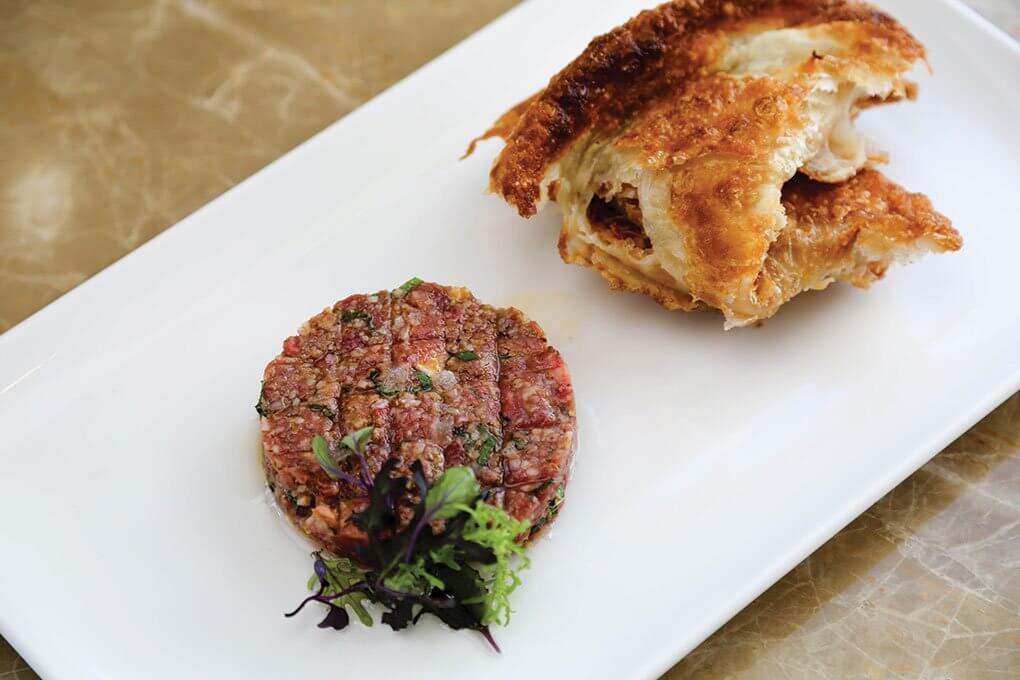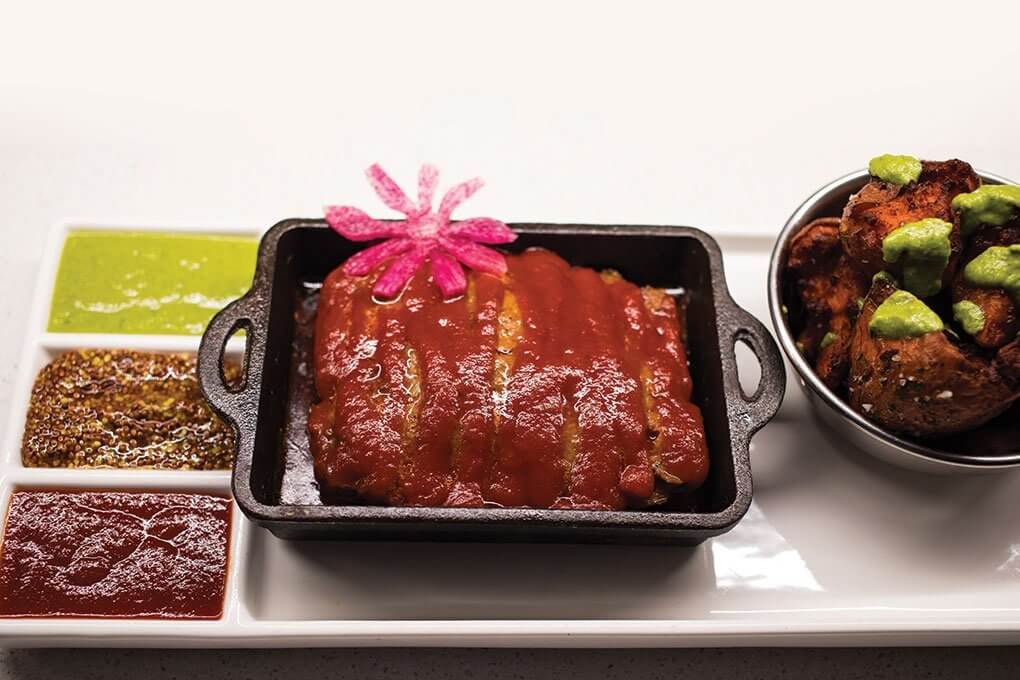Though sometimes it seems the entire industry is talking about produce, chefs and patrons have not lost their love of meat. Meat continues to be center stage, requiring flavor innovation to drive menu differentiation.
Chefs are challenged with cutting costs and increasing profit margins while creating new experiences for their guests. Today’s meat-centric trends are a direct result of these issues. Increased access to new cuts and varieties have facilitated greater cost control, while global influences are leading to new flavors and preparation techniques. Most diners still crave meats, and these menu opportunities can help set a center-of-plate program—as well as bar bites and shareables—apart from the rest.
Innovations in supply, production, processing and menu applications keep even the most common animal proteins from becoming mundane or predictable. The vast majority of patrons continue to look for meat on the menu, and chefs are responding accordingly with constant innovation and creativity. That innovation, fueled by an ongoing love affair with steak, lamb chops, pork ribs, et al, continues to keep meats firmly in focus for menu success.
Char Siu
WHAT?
A traditional Cantonese style of preparing pork, char siu literally means “fork roasted,” and creates a tender, craveable option with great visual appeal. It moves readily from Asian cuisine to global mash-ups, thanks to its accessible, sweet-charred barbecue flavor.
WHERE?
- Fried Min Noodles: Japanese noodles, char siu, Portuguese sausage, smoked ham, egg, onions, cabbage, bean sprouts
—Big City Diner, multiple locations in Hawaii - Char Siu Riblets with ginger, garlic, green onion, wonton strips
—McMenamins Restaurants, Pubs & Bars, based in Portland, Ore.
WHY?
Though traditionally Cantonese, this roasted-barbecue technique is present in an array of cuisines, including Japanese, Malaysian, Singaporean and Thai, and has worked its way to places with large Asian populations such as Hawaii. The term may be unfamiliar to many Americans, but the sweet-savory-sticky end result is a must-try. Char siu can be served in a traditional manner or applied across a variety of proteins.
Grass-fed
WHAT?
As free-range and sustainable have impacted the poultry and seafood categories, grass-fed, or pasture-raised, is now the practice of choice for a growing number of chefs looking for ethically raised, lean meat with clean flavor.
WHERE?
- The South Beach Flair Monster Burger: Grass-fed Angus beef burger, chipotle mayo, pepper Jack, chimichurri, plantains, brioche
—Sugar Factory, based in Las Vegas - Sonoran Grass-fed Steak Bowl with ancho-roasted corn, avocado, pickled onion, cabbage, cilantro, ancient grains, carrot lime habanero dressing
—Homegrown, Seattle
WHY?
Ethics continue to be a macro trend in food, with animal welfare holding steady within that trend. The health-and-wellness story around grass-fed has helped move it forward. Grass-fed can apply to most grazed animals, but is most commonly practiced with beef and lamb. The result is a leaner product with a clean flavor profile.
Free-Range Pork
WHAT?
While cows and sheep increasingly graze on grass, the new ethical practice with pork is free-ranging. Similar to chickens, the idea is that happier pigs with a more varied diet result in a better final product.
WHERE?
- Havana Daydreaming: Free-range house pork, shaved ham, Gruyère, pickles, sunny-side-up egg, cream cheese-hollandaise-Dijon mustard, hoagie roll
—Snooze, based in Denver - Fennel Pollen Pork: Free-range Michigan pork shoulder, extra-virgin olive oil, sea salt, herbs, wild fennel pollen
—Zingerman’s Delicatessen, Ann Arbor, Mich.
WHY?
Free-ranging pork has multiple benefits for the farmer. Since pigs are natural foragers, they help clean up the verge of forests for better land use and forest health. As they do so, they enjoy a varied diet beyond the traditional grain feed, which helps create a more nuanced taste. Although free-range pork is not widely available, its potential, given the demand for ethical and humane practices in food, is significant.
Game
WHAT?
Game is not new on U.S. menus, but it is becoming more broadly available. Advances in farming allow proteins such as venison, boar and rabbit to appear on mass-market menus rather than solely in fine dining.
WHERE?
- Venison Chili with pepper Jack, red onions
—Twin Peaks, based in Dallas - Pappardelle al Cinghiale: Fresh pasta ribbons, wild boar ragout, shaved Parmigiano
—Tuscany, three locations in Illinois
WHY?
Game is a common protein in some regions of the U.S. and all over the world. It has a bolder flavor than most raised proteins, though farmed varieties can have a more muted profile than wild-caught. Menuing game encourages operators to feature more authentic or traditional dishes, and to create unique variations of items not traditionally served with game meat.
Carnitas
WHAT?
Carnitas, or “little meats” in Spanish, usually refers to braised pork simmered in oil until tender and juicy. Today, pork carnitas still rules the roost, but both lamb and chicken carnitas are making headway on menus. Whatever the protein star, carnitas are moving beyond the traditional taco format; they can now be seen over loaded fries, in bowls, salads and more.
WHERE?
- El Camino: Poached egg, avocado, pulled-pork carnitas, black bean salsa, red cabbage, fried tortilla, cilantro
—Egg Shop, two locations in New York - Carnitas Bowl: Chicken carnitas, diced onion, lemon, cilantro, pico de gallo salsa atop Spanish rice and pinto beans
—El Pollo Loco, based in Costa Mesa, Calif.
WHY?
With the dining consumer’s continued love of all things Mexican—along with a deepening path of global mash-ups—carnitas serve up a craveable meat dish that can move into almost any format, bringing the promise of deliciousness with the credibility of street food.
Meatloaf
WHAT?
Probably the most comfort-centric dish in American cuisine, meatloaf is a sure thing when it comes to familiar favorites. And much like its diminutive cousin the meatball, it can take on all sorts of global and eclectic flavor combinations.
WHERE?
- Lamb & Oat Meatloaf: Lamb, beef, organic ketchup, pumpkin-seed salsa verde, crispy sweet-potato bites
—River and Woods, Boulder, Colo. - Meatloaf with Sriracha glaze, mashed potato and morel gravy
—Unconventional Diner, Washington, D.C.
WHY?
Meatloaf offers a beloved platform for serious innovation. It’s a blank canvas—loved by many—ready for a brand’s signature touches, all the while promising a satisfying, hearty meal.
New Cuts
WHAT?
Chefs are looking for new or lesser known cuts of meat to vary traditional dishes. A world of new cuts is now available, rapidly making its way onto menus, offering value, interest and flavor along the way.
WHERE?
- Coulotte Steak with skordalia, tomato consommé, mushroom conserva, pine nuts
—Beast + Bottle, Denver - Rio Bravos Steak Tacos: Tortillas, grilled shoulder tenderloin steak, chipotle cream cheese, pico de gallo, pepper Jack
—Sam Diego’s, two locations in Massachusetts
WHY?
Many of the newer cuts utilize under-leveraged main cuts and cost less. New cuts can help create excitement in a category such as steak, where patrons are loyal, but respond to creative menuing. Oyster steaks, coulotte steaks, merlot cuts, Vegas strip steaks, and shoulder tenders—to name a few—all give chefs options for innovation and cost control.
Raw Preps
WHAT?
Tartare is a classic preparation that fell out of favor amid safety concerns and changing consumer behavior. But the growth of raw options on the seafood side has naturally led to the re-imaging of tartare and other raw preparation techniques in other meats.
WHERE?
- Carne Apache: Citrus-cured fresh ground beef with tomato, onion, jalapeños, cilantro with two tostadas and escabeche
—Conin Mexican Cuisine, Portland, Ore. - Kibbeh Nayeh: Louisiana beef tartare, bulgur, walnuts, Yemenite flatbread
—Shaya, New Orleans
WHY?
Many world cuisines feature some type of non-fish raw preparation, including cig kofte (Armenian/Turkish), crudo (Chilean), kitfo (Ethiopian), and mett (German). Acceptance of raw proteins started with sushi and continued with ceviche and poke but is quickly moving into the animal-protein category. Safer meat products and more reliable sourcing have contributed to its growth.
Burnt Ends
WHAT?
Is there any category of food in which people don’t love the burnt bits? Meat is no exception, and chefs are taking advantage of these burnt ends to create interesting and craveable items.
WHERE?
- Burnt Ends: Hickory-smoked beef brisket ends with dry-rub seasoning, served with a side of bourbon-molasses sauce for dipping
—Red Hot & Blue, based in Winston-Salem, N.C. - Brisket Burnt Ends: Filet mignon meets beef jerky; smoked for up to 24 hours, caramelized, smoked again for two more hours
—Q-BBQ, Chicago
WHY?
Burnt ends are the continuation of where the jerky trend left off. Long a hidden secret at barbecue joints, burnt ends are finding their place on more menus and enjoying the same treatment as pork belly and bacon. Whether served on their own or leveraged as a topping, burnt ends add nuggets of craveable goodness to a variety of dishes.
… And Waffles
WHAT?
Chicken and waffles have been around far longer than the industry has been tracking trends, but trending they are. This combination continues to grow, and the popularity of waffles as a protein accompaniment is moving beyond the typical chicken combination.
WHERE?
- Chicken and Waffle: Pork belly, green-apple waffle, sausage gravy, honey butter
—McCormick & Schmick’s, based in Portland, Ore. - Fried Pork Chop and Cheddar Waffles with Poor Farm maple syrup
—Buttermilk Channel, Brooklyn, N.Y.
WHY?
Waffles at breakfast are sometimes passed over because of the indulgence factor and lack of portability. Pairing with an animal protein, focusing on more adult flavors, and moving into the lunch or dinner space gives more patrons permission to enjoy them. Innovations around the meat-and-waffle pairing are moving it far from its original Southern roots.
 Randy P Schmidt
Randy P Schmidt The Kibbeh Nayeh at Shaya in New Orleans is a raw pattie of minced beef and lamb with walnuts, pomegranate, bulgur, mint, spices and pomegranate molasses, served with malawach, a Jewish fried bread.
Meat will always reign supreme—even as produce enjoys greater exposure across the menu. In fact, the produce-forward trend has amplified meat’s importance in craveability, providing needed bursts of umami in veg-centric dishes. But as star of the plate, meat can serve many purposes, from creating more robust and satisfying dishes to increasing price points and elevating the ordinary.
Consider the benefits and potential for meat on the menu:
Applications
- Global sandwiches and handhelds
- New breakfast options
- Unique appetizers and bar bites
- Inclusions with pastas, rice and grain dishes
- Bowl components
- Center-of-plate stars
- Raw applications like tartare or kibbeh
- Garnishes on produce and meat-centric dishes
- Garnishes in brunch cocktails
Benefits/Functions
- Increase perceived value at higher price points
- Raise profit margins (with new cuts, etc.)
- Add “heft” or gravitas to dish
- Create baseline familiarity for innovation
- Upsell bar snacks and shareables
- Elevate traditional applications
- Add universal appeal to the broad market











